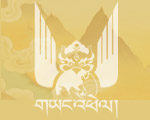 Bhutan's
national flag is a white dragon on a diagonally divided background
of golden yellow and reddish orange. The yellow represents the
secular power of the King, the orange the Buddhist religion.
The white of the dragon is associated with purity, and the jewels
held in the claws stand for the wealth and perfection of the
country. The national emblem is composed of a double diamond
thunderbolt placed above a lotus, surmounted by a jewel and
framed by two dragons, all contained within a circle. The thunderbolt
represents the harmony between secular and religious power resulting
from the Vajrayana form of Tibetan Buddhism, the lotus symbolizes
purity, the jewel expresses sovereign power and the two dragons,
male and female, stand for the name of the country, Drukyul,
the land of the thunder dragon. Bhutan's
national flag is a white dragon on a diagonally divided background
of golden yellow and reddish orange. The yellow represents the
secular power of the King, the orange the Buddhist religion.
The white of the dragon is associated with purity, and the jewels
held in the claws stand for the wealth and perfection of the
country. The national emblem is composed of a double diamond
thunderbolt placed above a lotus, surmounted by a jewel and
framed by two dragons, all contained within a circle. The thunderbolt
represents the harmony between secular and religious power resulting
from the Vajrayana form of Tibetan Buddhism, the lotus symbolizes
purity, the jewel expresses sovereign power and the two dragons,
male and female, stand for the name of the country, Drukyul,
the land of the thunder dragon.
Bhutan is the only country to maintain Mahayana Buddhism
in its Tantric Vajrayana form as the official religion. The
main practicing schools are the state sponsored Drukpa Kagyupa
and the Nyingmapa. Buddhism transects all strata of society,
underpinning multiple aspects of the culture. Indeed, religion
is the focal point for the arts, festivals and a considerably
above average number of individuals. The presence of so many
monasteries, temples and stupas, monks and tulkus (reincarnations
of high lamas) is indicative of the overarching role religion
plays throughout the nation.
Although the Shabdrung is regarded as the founder of the
nation, the secular realm has achieved an unprecedented degree
of unity under the influential guidance of a Twentieth Century
monarchy. Within a cultural context where the spiritual and
temporal spheres are intimately connected, political leadership
remains interpreted as divinely determined. The royal family
traces its roots to the great Sixteenth Century saint Pema
Lingpa, and the present monarch still enjoys a god-like status
throughout much of his Kingdom. The Forth King Jigme Singye
Wangchuck as the head of state now rules the Kingdom, with
the throne retaining its position as the fulcrum of the political
system.
Bhutanese art possesses a major Tibetan influence, although
it has developed some of its own derivations. It has three
main characteristics: it is anonymous, religious and performs
no independent aesthetic function. Intricate wall paintings
and thangkas (wall hangings), most historical writing and
fine sculpted images all have a religious theme. Given their
role, these may be interpreted as created by artisans rather
than artists, although there exist many extremely fine examples.
All are viewed as sacred, and newly commissioned paintings
and sculptures are consecrated through a special ceremony
whereby they come to personify the respective deities.
Although both Buddhism and the monarchy are critical elements,
it is the general extensive perpetuation of tradition that
is possibly the most striking aspect of Bhutan's culture.
This is most overtly reflected in the nature of dress and
architecture. All Bhutanese continue to wear the traditional
dress: for men and boys the gho, a long gown hitched up to
the knee so that its lower half resembles a skirt, for women
and girls the kira, an ankle-length robe somewhat resembling
a kimono. Generally colorful apparel, the fabrics used range
from simple cotton checks and stripes to the most intricate
designs in woven silk.
The Bhutanese architectural landscape is made up of chortens,
stonewalls, temples, monasteries, fortresses, mansions and
houses. Associated with a number of clear-cut architectural
concepts and building types rooted in Tibetan Buddhism, there
is a strong association between state, religious and secular
forms. What makes it quite unique is the degree of uniformity,
with all structures corresponding to traditional designs.
Thus ancient monasteries and fortresses appear to merge with
more modern popular dwellings to create a setting that is
fully internally consistent.
|



